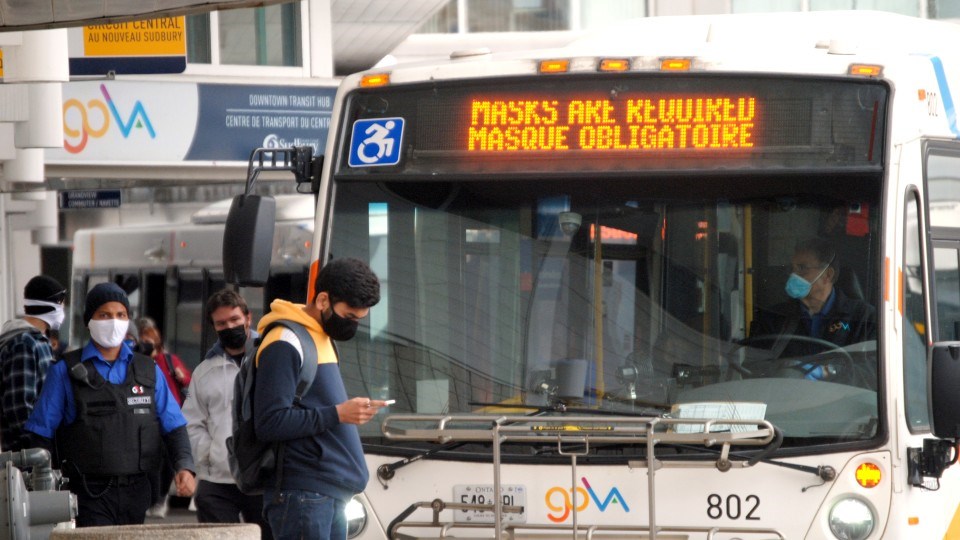As Greater Sudbury slowly eases into the “new normal” that’s been bandied about for months, more people are making a return to public transportation.
While they do so, and as the COVID-19 pandemic lingers in large part due to the more infectious Delta variant and the unvaccinated, safety measures remain paramount.
Passengers aboard GOVA Transit buses are still required to wear masks and maintain physical distancing whenever possible, city director of transit services Brendan Adair said.
Plus, buses are still being deep-cleaned and sanitized at the end of each shift, and bus drivers sit behind one of two styles of barrier installed throughout the fleet.
“We work really hard to ensure our buses are not only on time and reliable, but a safe place for the community,” Adair told Sudbury.com, adding that they’ve been working to uphold Public Health requirements throughout the pandemic.
September found ridership hit a pandemic high of approximately 277,000, which Adair said still falls far short of the 467,000 people who boarded buses in September 2019.
Still, it’s a significant boost from the low point in the pandemic, in April 2020, when only 149,877 rides were counted.
This, Adair said, “is exciting to see after what we’ve gone through for the pandemic.”
It’s likely this boost in ridership has come as a result of climbing vaccination rates and a return to in-person learning at post-secondary institutions, he said, which signals the beginnings of a return to normalcy.
The City of Greater Sudbury responded to the pandemic swiftly in March 2020 by scaling back various services, including GOVA Transit.
During these early days, bus fares were temporarily waived and riders were instructed to board and exit buses through the rear doors only in order to maintain a distance between themselves and the operators.
Mask mandates and barriers have since resolved this problem, Adair said. Although drivers are occasionally seen not wearing masks while driving, it’s only when passengers are not boarding or exiting and when they can maintain two meters of distance, all the while behind their barrier.
Fares resumed on June 15, 2020, masks were mandated the following month and some previously suspended routes were reintroduced in August 2020.
The GOVA downtown transit hub, which closed in March 2020, reopened in January, and although Adair said there have been ups and downs since that time, the current trend remains positive.
As more people use public transit, he said educating users about health regulations is ongoing, “even 19 months into the pandemic.”
Although masks are still required, he said a small minority of people still aren’t wearing them.
“A bus operator will remind them in terms of their mask, but as it is in legislation, we won’t refuse services,” he said, adding that if a rider creates a problem the operator can always phone enforcement officers to attend the scene.
“There’s been a great reception to that education piece and from a safety standpoint, bus operators knowing they have someone to call has been a great support for us,” Adair said.
“For the most part, we’re very happy with the support of the community in terms of their acceptance of the regulations and they understand that we’re in this together.”
Greater Sudbury bylaw officers, in general, have strived to take an education-first approach throughout the pandemic.
Meanwhile, as more people begin boarding buses again it will become increasingly difficult for riders to physically distance themselves from others.
There are no capacity limitations for GOVA Transit vehicles, and Adair said people are encouraged to distance themselves “where they can.”
“Riders who have capacity concerns should let the city know by phoning the 311 customer service line,” Adair said.
Further, GOVA Transit has the ability to close buses to additional passengers in the event they’re full, in which case subsequent passengers are picked up using a secondary bus.
Operators monitor how many passengers are on each bus and new technology allows for a better real-time counting of passengers by supervisors at the terminal.
With ridership still a shadow of its former self, Adair said they haven’t had to resort to this yet, but the option is available in the event it becomes necessary.
Underpinning everything, he said, is the dedicated work of transit operators, who have maintained required service levels throughout the pandemic.
“Many of us … got the opportunity to work from home, and this set of employees worked diligently throughout, with the ups and downs, and I understand it could be a challenge some days,” he said. “Thanks for a great group of people.”
Tyler Clarke covers city hall and political affairs for Sudbury.com.
